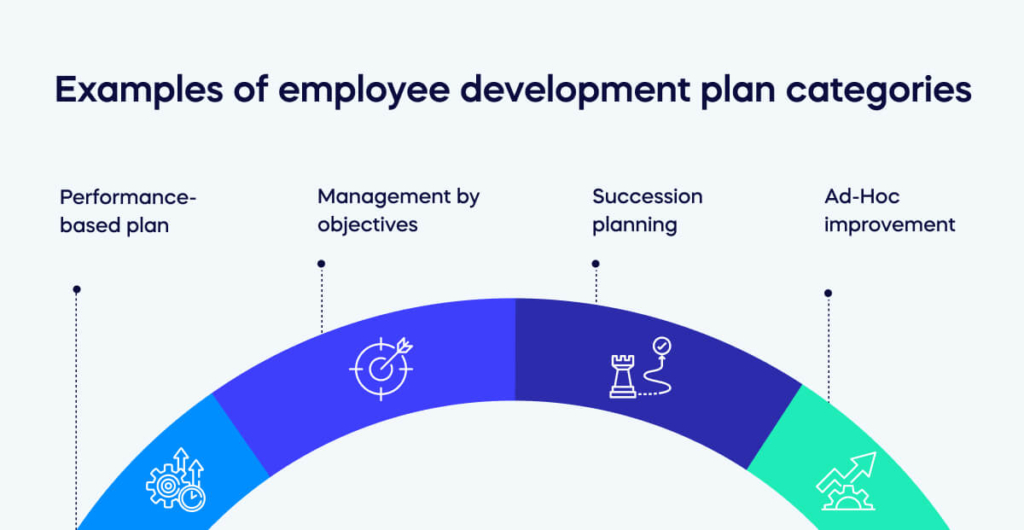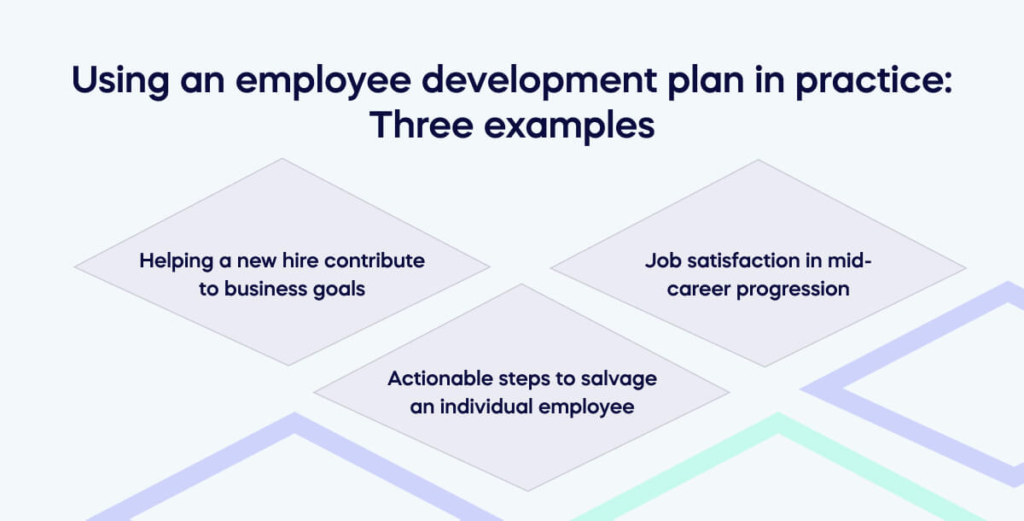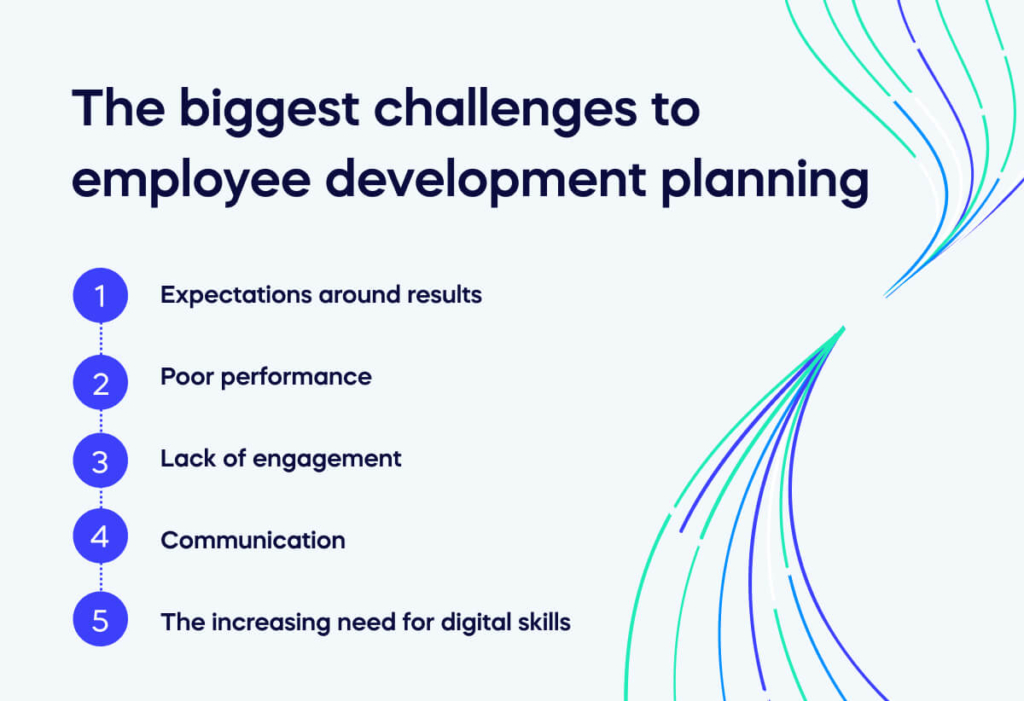Employee development plans are vital for improving each employee’s progress in an organization. They ensure that everyone has clear and structured career development plans. The employee development plans in this article illustrate how these documents can be highly effective.
Few things slow productivity as much as feeling stuck professionally. An employee development plan offers an avenue for the long-term development of professional skills. But these programs don’t just benefit employees; they also help the organization itself.
Employee development programs can improve organizational culture, employee performance, engagement, and success when properly implemented. As employers, it is in your best interest.
So, in this article, we’ll help you with wide-ranging examples of the employee development plan. We will:
- Explain four major categories of employee development plans;
- Examine real-life employee development plans from organizations around the world;
- Provide three case studies of development plans in action.
After discussing these many examples, we’ll go into some of the background for employee development planning, with a series of sections about the importance of employee development.
Gallup found that when companies strategically invest in employee development, they report 11% greater profitability and are two times more likely to retain their employees. And this makes sense. Pursuing “career growth opportunities” is why people leave their jobs. So, if you have not mastered your employee training plan yet – now’s a great time to check out these examples and get some inspiration!
Examples of employee development plan categories

In this section, we’ll introduce key examples of types of employment development plans. We’re starting here because your goals and approaches for employee development will influence all your decisions about the formal characteristics of planning.
In this section, we’ll look at four types of employee development plans:
- Performance-based plan
- Management by objectives
- Succession planning
- ad-hoc improvement
Together, these will show you how employee development plans are useful in many organizational matters for both the employee and the organization.
Performance-based plan
This plan uses the logic of a grade school report card.
Students who work hard and are awarded A’s are the ones who make the honor roll for the semester. At the very least, students study to get passing grades. Similarly, employees are more focused when working toward a goal each quarter in a workplace setting.
However, success in the workplace is not always quantitative. For salespeople, it is simple to set and work toward a certain numerical target. The outcome is either yes or no. But the numbers are not the whole picture.
If you use a performance-based professional development plan, consider other aspects of employees’ experience, such as professional growth throughout the quarter and motivation.
This type of thinking leads to the feed-forward review, which focuses on the employee’s best moments and how they can implement what they’ve learned in future projects.
Management by objectives
This employee development plan is similar to performance-based but relies on shorter-term goals. Rather than following goals from management, employees set their own individual milestones. Those milestones then work together toward the overall organizational goal.
This plan is more proactive than reactive. Instead of looking back at performance and evaluating backward, employees can modify goals as time passes and as they see fit. This plan makes it so employees are constantly self-evaluating and improving their performance.
Succession planning
Many organizations already have a career ladder, which is why this employee development plan is called succession planning. With succession planning, employees are placed somewhere on the ladder and work toward a promotion or more senior role as time goes on.
This longer-term type of planning caters well to mentorship programs, whether cross-departmental or with someone a few steps up on the same ladder.
Mentorship can be a beneficial development tool for both the mentor and mentee, adding value to this option. Mentors are typically further along in their careers and can advise on how they’ve gotten to where they are, as well as general industry wisdom.
Ad-hoc improvement
This highly individualized plan works best on sole employees rather than with groups. It is based on a mentorship program, similar to the succession plan, but focuses more on the mentee’s needs.
Timing is extremely important for this type of employee development. It is important to be responsive when an employee desires to learn more — they may lose interest if you wait too long.
While this plan is more informal, it is great for employees who want to improve on specific new skills that will help their careers advance.
Employee development plans are not plug and play. All the same, it is well worth the time spent implementing and facilitating growth. Employee development plans drive value for the organization, reduce employee churn, and improve overall productivity.
Employee development plan examples in action
So, the previous section showed us the aims of employee development plans. But these are highly practical documents. So, to understand how they work, we need to look at some “real-life” examples.
This section will look at examples from three sources: the UK’s civil services, Canada’s Prince Edward Island health system, and the US inter-departmental HR agency. These are drawn from the public sector. They nonetheless illustrate the key principles at work in any employee development plan. Furthermore, you could use them as a development plan template.
Professional development in the UK’s Civil Service
The HR function of the UK’s Civil service has a clear and effective employee development plan.
It’s a five-page document with these features:
- A skills audit: highlighting the skills – needed NOW, needed in the long term, and the skills they already have
- Goal-setting: Identifying three targets for the next year
- Timeline: a quarterly breakdown of L&D for the single year ahead – by quarter
- Reflection: for Mid-year and end-of-year.
You could call this plan a “living document.” It has the space for employees to grow in their understanding and knowledge. As the year rolls on, there’s a good chance that the employees will discover new things about their development capacity.
Development initiatives from the Canadian health system
Now, let’s look at a plan from a smaller organization – the health care system for Canada’s Prince Edward Island.
The employee development plan is usefully included in Appendix A of their Learning and Development framework. Two key areas for workers to engage with are their leadership goals for the year and an accountability contract.
This plan is effective, however, because it asks for further information about these areas. The “goals” section also asks for learning methods, deliverable results, and timeline.
The accountability contract makes the participant consider time, money, and the challenges to their learning.
The PEI plan is a good method of responsive and supportive development planning.
Employee development plans from US governmental departments
One of the best-kept secret resources for employee training plans is the USA’s Office for Personnel Management. They emphasize that no legal mandate exists for any particular form and support HR managers by providing numerous examples from different departments.
A quick look through the plans online will show you just how different employee training plans can be.
At the “simple” end of the scale, there’s the Department of Labor’s development plan. It’s a two-page document comprising an “action plan” for achieving goals, with further space for comments from the employee, supervisor, and counselor.
Meanwhile, the Small Business Administration adds to these core sections. On top of an action plan, they include an audit of current strengths and weaknesses, plus space to think about one and three-year goals. The action plan also comes with a lot of suggestions about how to use it.
These examples from the USA remind us that every organization is responsible for employee development. In changing circumstances, it’s fine to revise, reconfigure, and re-develop documentation to suit the needs of the day.
Using an employee development plan in practice: Three examples

Now that we’ve seen some standard types and formats for employee development plans, you’ve got some extremely useful tools for employee development. This section will see how these tools can work in practice, with three example case studies.
Our case study examples show how employee development plans are useful for new hires, mid-career development, and saving poor employees. Across these three cases, the development plan directs the employee’s attention to the training needs that will help them the most.
Example 1: Helping a new hire contribute to business goals
A recent computer science graduate, Emily began his career as a junior software developer at Tech Innovators Inc. Despite her excellent academic background, she lacked practical experience. The company recognized her potential and hired her confidently.
Like many new employees, Emily faced challenges in her role. Those included a lack of hands-on experience, skill gaps, and communication issues. To address these, she and she got together to create an effective employee development plan. After looking at her “areas to improve,” they set specific goals, including mastering programming languages and improving his communication skills. As a result, Emily participated in targeted training, received mentorship from a senior engineer, and worked on real projects.
Gradually, Emily’s skills developed to help support the company’s work. She developed competency In specific applications of Python and JavaScript. And although she is still a nervous communicator, she understands how to express herself much better.
Example 2: Job satisfaction in mid-career progression
Meet Michelle, a mid-career professional at Clevertech Global who embarked on a transformative journey through a meticulously crafted employee development plan.
Michelle, an experienced project manager, had reached a point in her career where she sought growth and advancement. Recognizing her potential and commitment, the company invested in her professional development.
Mid-career professionals like Michelle often face challenges – such as a stagnant career trajectory, skill gaps in emerging technologies, and a desire for increased leadership responsibilities. To address these challenges, Michelle and her manager, Alicia, collaborated to formulate a tailored development plan.
The objectives set for Michelle were both ambitious and achievable. She aimed to enhance her proficiency in project management methodologies, gain expertise in data analytics, and strengthen her leadership skills. Her development journey began with a carefully curated blend of online courses, workshops, and seminars. These learning opportunities allowed her to deepen her project management knowledge and dive into data analytics.
With her newly acquired skills, Michelle could apply for internal promotions. After a few applications, she got a leadership position using all her training outcomes.
Example 3: Actionable steps to salvage an individual employee
Employee development plans also have a different purpose: to help “bad” employees improve. That’s what we will see in Sarah’s story.
Sarah’s initial journey as a junior store manager was marked by struggles and underperformance that nearly led to her termination. Her inability to effectively manage the store, frequent operational errors, and lackluster team performance had put her on the verge of dismissal. Instead of letting her go, Horizon Retail recognized the untapped potential within Sarah and implemented a thoughtful employee development plan.
The objectives of Sarah’s development plan were crystal clear. Her immediate goal was to improve her store management skills significantly, while her long-term aspiration was to become a valuable asset to the company. To accomplish this, Horizon Retail orchestrated a series of training sessions, workshops, and mentoring opportunities to boost her capabilities.
As Sarah moved through her development plan’s goals, her strengths came out more and more. She was less stressed about work and, over time, gradually improved. Horizon Retail’s willingness to invest in Sarah’s growth resulted in an employee who overcame her challenges and became an integral part of the organization’s success.
What is employee development?
Employee development, career development, training, and development are all commonly used terms in HR, but there are differences between them.
Employee development
Employee development refers to long-term training, education, and development activities to improve an employee’s organizational capabilities and value. These programs are implemented and managed by organizations. While employees benefit from these programs, they aim to help a company first and employees second. Of course, since employee development efforts are built around improving professional skills, workers will naturally stand to benefit.
Therefore, many organizations use employee and career development programs to attract and recruit talented employees. Done right, employee development programs can become tools that deliver measurable ROI, improving the workforce, the workplace, and organizational performance.
Career development
Career development refers to training and development efforts centered around an employee’s career interests and professional development.
While employee development programs are intended to improve the workforce’s performance, the employee’s needs take precedence in career development. Since these programs emphasize an employee’s career goals, they will be more personalized and flexible in their content.
Despite these differences, both approaches can serve as excellent tools for recruiting and retaining talented workers.
Employee training
Employee training refers to on-the-job training that provides workers with the skills they need to perform their jobs.
Training often begins early in an employee’s career at a company – often on the very first day of work. Training forms a core part of the two development programs mentioned above, which is why they are used together in the term “training and development.”
Development programs differ from training programs because they focus on long-term professional improvements. They can include other types of education that don’t fall under the “training” umbrella, such as mentorship programs, workshops, seminars, or other educational activities.
Training is the most critical business activity of the three since it imparts the fundamental skills that employees need to do their day-to-day work. However, given the affordability and the advantages of offering long-term development programs, many organizations provide all three.
Why use an employee development plan?
When employees are actively learning and improving in their field, they will be more engaged and productive. An employee development plan is a recruitment and retention tool offering a structured professional growth approach.
According to a study by The Society for Human Resource Management, employees participating in a development program are more satisfied and feel that their employers recognize them for their value. With additional learning opportunities, they are better prepared to take on more challenging projects and roles. This also sets them on a track toward leadership positions within the company.
However, these plans do not simply fall into our laps; they take time and maintenance to create and implement. Typically, the HR department handles the planning while managers and leaders play secondary roles.
What are the biggest challenges to employee development planning?

Employee development efforts can run into several setbacks and obstacles, such as:
- Expectations around results
- Poor performance
- Lack of engagement
- Communication
- The increasing need for digital skills
Overcoming these challenges is not difficult and can be resolved through proper foresight and the appropriate training measures.
Who should lead training?
In most organizations, HR or training departments will handle employee development planning.
Those providing the actual training will differ, depending on the circumstances.
Mentors, as mentioned, can provide career-oriented advice and knowledge, which can be a useful approach to succession planning.
However, many other vehicles can be used to assist with employees’ professional development, such as:
- Workshops and seminars
- Online courses
- Digital adoption platforms (DAPs)
It is worth taking the time to find the most appropriate training tools and methods to maximize the outcomes of training and development efforts.
Choosing the right software for employee development
Software, tools, and technology can be instrumental in short- and long-term training.
Training Tools
Today, many skills training revolves around the digital workplace, which is why digital training solutions are vital.
For example, digital adoption platforms (DAPs) can be excellent for developing digital skills. These digital adoption tools act as UI and training layers that deliver contextualized, interactive guidance directly inside other applications. DAPs are modern training solutions that can be used for both on-site and remote training.
They provide continuous, virtual training through several key features, including:
In-app walkthroughs. In-app walkthroughs take users one step at a time through a workflow. These walkthroughs are automated and user-friendly, showing users exactly what to do at each stage. However, since users are performing the tasks themselves, they are more likely to remember the actions than if they passively receive the information via text or video.
Product tours. A product tour quickly demonstrates a product’s core features to new users, helping them quickly understand the application’s gist and value. Tours can simplify new user onboarding, accelerating time-to-productivity and minimizing potential frustration.
Contextualized, interactive guidance. Given the inherent complexity of enterprise-grade software tools, employees will naturally need to seek out help occasionally. Virtual, interactive assistance allows employees to retrieve contextually relevant information in the moment of need, decreasing reliance on technical support.
Software analytics. Analytics can track users’ interactions with a software application, giving managers insight into training needs. This information can improve walkthroughs, enhance training efforts, or implement other corrective actions as needed.
When used in conjunction with other employee development tactics, such as mentorship programs, DAPs can minimize learning timelines while maximizing performance and results.
Remote training and development
Remote working, the virtual workplace, and digital workflows are all becoming the norm, which is why employee development programs should cater to the needs of the modern digital worker.
Employee productivity in the digital age depends heavily on digital literacy and digital skills. And since the modern workplace is rapidly becoming more virtual and remote, it is more important than ever to offer remote training and development options.
These can include:
- Digital employee training solutions that can operate anywhere, such as digital adoption platforms (DAPs)
- Teaching employees how to work remotely
- Providing mobile-friendly, on-demand training options
Working from home has become far more common in recent years due in part to the advantages it offers workers and organizations. The COVID-19 crisis also demonstrated the value of remote work as a disaster mitigation plan.
Remote work will likely become more prevalent in the coming years, so it pays to incorporate this into employee development programs as much as possible.
How an employee development plan enables business continuity
Today, digital innovation, natural disasters, and crises can all disrupt business models, making business continuity a top priority for most organizations. Maintaining continuous, stable operations is no easy task, however – ensuring business continuity requires organizational agility, strategic digital transformation, and adaptability.
Continual organizational change means that employees become perpetual learners. Digitally skilled workers are in high demand, and, as mentioned above, a lack of digitally skilled workers can impede innovation.
One of the best ways to maintain a skilled workforce is through employee development programs.
To this end, setting specific targets that revolve around reskilling and upskilling is useful.
When an organization adopts new software, workflows must be redesigned, and employees must be retrained. Though new technologies offer great potential value, effective employee onboarding and training are a must. In other words, employee development programs can be leveraged as a vehicle to maintain employee skill levels while simultaneously improving their levels of engagement and motivation.
Skills and abilities that will be needed both today and in the future. Since many organizations are undertaking digital transformation efforts, it is necessary to prepare employees for the workplace of tomorrow. According to the World Economic Forum, many of today’s most in-demand jobs didn’t even exist five or ten years ago. And since the pace of change is only set to increase, it is important to provide employees with training and development plans that prepare them for tomorrow’s work world – not today’s.
It works for both the organization’s needs and employees’ needs.
Employee development plans should be designed to meet an organization’s needs, first and foremost. However, if these plans enhance the employee experience and serve as an effective recruitment tool, they must also meet employees’ needs.
For best results, managers should design programs that meet the needs of both parties. Training and development can fuel business continuity and employee success with the right approach, which is why employee development plans are so valuable.

